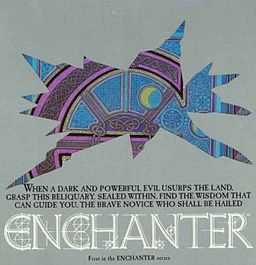Enchanter (video game)
| Enchanter | |
|---|---|
 Cover art | |
| Developer(s) | Infocom |
| Publisher(s) | Infocom |
| Designer(s) | Marc Blank and Dave Lebling |
| Engine | ZIL |
| Platform(s) | Amiga, Amstrad CPC, Amstrad PCW, Apple II, Apricot PC Atari 8-bit, Atari ST, Commodore 64, CP/M, DEC Rainbow, Kaypro II, Apple Macintosh, NEC APC, Osborne 1, MS-DOS, PDP-9, PDP-10, PDP-11, TI-99/4A, TRS-80.[1] |
| Release date(s) |
|
| Genre(s) | Text adventure |
| Mode(s) | Single-player |
| Distribution | 3½" or 5¼" disk |
Enchanter is a 1983 interactive fiction computer game written by Marc Blank and Dave Lebling and published by Infocom. It belongs to the fantasy genre and was the first fantasy game published by Infocom after the Zork trilogy (it was originally intended to be Zork IV). The game had a parser that understood over 700 words, making it the most advanced interactive fiction game of its time. It was Infocom's ninth game.
Plot
Krill, an incredibly powerful evil warlock, is spreading chaos and destruction. None of the more experienced members of the Circle of Enchanters dare to attempt to stop him. In desperation, the player, a novice Enchanter with only a few weak spells in his spell book, is sent in hopes that Krill will either fail to detect him or dismiss him as harmless. More powerful spells can be found on scrolls hidden in various locations, but as the player becomes more of a threat, Krill will respond accordingly.
This game features an innovative new spell system based partially on Ursula K. Le Guin's Earthsea series and partially Dungeons and Dragons' Vancian spell system, where spells must be prepared through "memorization" before being cast. As in the Earthsea series, each spell is represented by some nonsense "magic word" which is treated as a verb by the game's text parser, so that one can use the FROTZ spell (which causes objects to glow and give off light) by typing >FROTZ BOOK, in exactly the same way as one might type >PICK UP BOOK or >READ BOOK.
There are references scattered throughout Enchanter's documentation and gameplay comparing the use of spells by mages to the use of command line interfaces by programmers, and comparing mages to hackers in general. Many of the spell names, such as FROTZ and GNUSTO, are taken from MIT hacker slang of the time; others are various pop cultural references or anagrams. (For instance, the NITFOL spell allows one to speak with animals, and NITFOL is a truncated reversal of "LOFTING", after the author of the Doctor Dolittle stories.)
Notes
Frotz, a modern open-source interpreter for Infocom games (as well as independently written interactive fiction) draws its name from a spell ("cause object to glow with illumination") in Enchanter and its sequels. Another spell, Blorb ("hide an object in a strongbox"), provides the name for a standard wrapper for interactive fiction multimedia resources. Several other IF tools have also been named after spells from the series.
This was the first game of a trilogy, usually referred to as "The Enchanter Trilogy". The others in the series are 1984's Sorcerer and 1985's Spellbreaker. It was also intended, at one point, to be a sequel of sorts to the Zork trilogy. In the game Zork III, a device slowly cycles through "scenes" from each of the Zork games as a number is displayed above it. A depiction of the sacrificial altar from the then-unreleased Enchanter appeared under the number "IV".
Robin Wayne Bailey's 1989 novel Enchanter is a companion rather than a novelisation.
Infocom rated Enchanter as "Standard" in difficulty.
Enchanter is the only game in the Zork universe where lurking grues, although they still exist, are not mentioned by name; the game doesn't even know the word "grue".
Reception
Computer Gaming World praised the game as "typically excellent" and up to the standards expected of Infocom games.[2] Ahoy! wrote that "Enchanter is filled with the usual Infocom doses of wit, red herrings ... twists, turns, and surprises". It stated that while beginners would enjoy it experienced text adventure gamers "may be disappointed. There didn't seem to be a whole lot to do. I solved the game in record time, for me; it left me wanting more ... The very moniker "Infocom" may be raising my expectations too high".[3] John J. Anderson wrote in Creative Computing "With Enchanter, they have scored again ... Enchanter is full of the delightful little touches we have come to expect from Infocom."[4] Compute! stated that Enchanter had "nothing strikingly original about it, but you'll appreciate its high level of challenge and meticulously maintained continuity". It stated that "some of the humor lacks, well, subtlety", citing the name Dimwit Flathead as example, and that "the narrative won't win any literary awards, either".The magazine concluded that it "is an excellent game for adventure freaks".[5]
Historian Jimmy Maher wrote in 2013 that Enchanter has "a brilliant collection of interlocking puzzles that are challenging but solvable".[6]
References
- ↑ Enchanter by Hans Persson and Stefan Meier
- ↑ Scorpia (December 1983), "Micro-Reviews: Enchanter", Computer Gaming World: 43–44
- ↑ Lobl, Pete (1984-03). "Enchanter". Ahoy!. p. 58. Retrieved 27 June 2014. Check date values in:
|date=(help) - ↑ Anderson, John J (March 1984). "Enchanter; Infocom: the Steven Spielberg of text adventuring". Creative Computing. p. 153. Retrieved February 26, 2013.
- ↑ Berman, Marc (December 1984). "Enchanter". Compute! (review). p. 135. Retrieved 30 October 2013.
- ↑ Maher, Jimmy (2013-04-03). "Enchanter". The Digital Antiquarian. Retrieved 10 July 2014.
External links
- enchanter at MobyGames
- View Enchanter packaging at the Gallery of Zork.
- Bugs in Enchanter
| ||||||||||||||||||||||